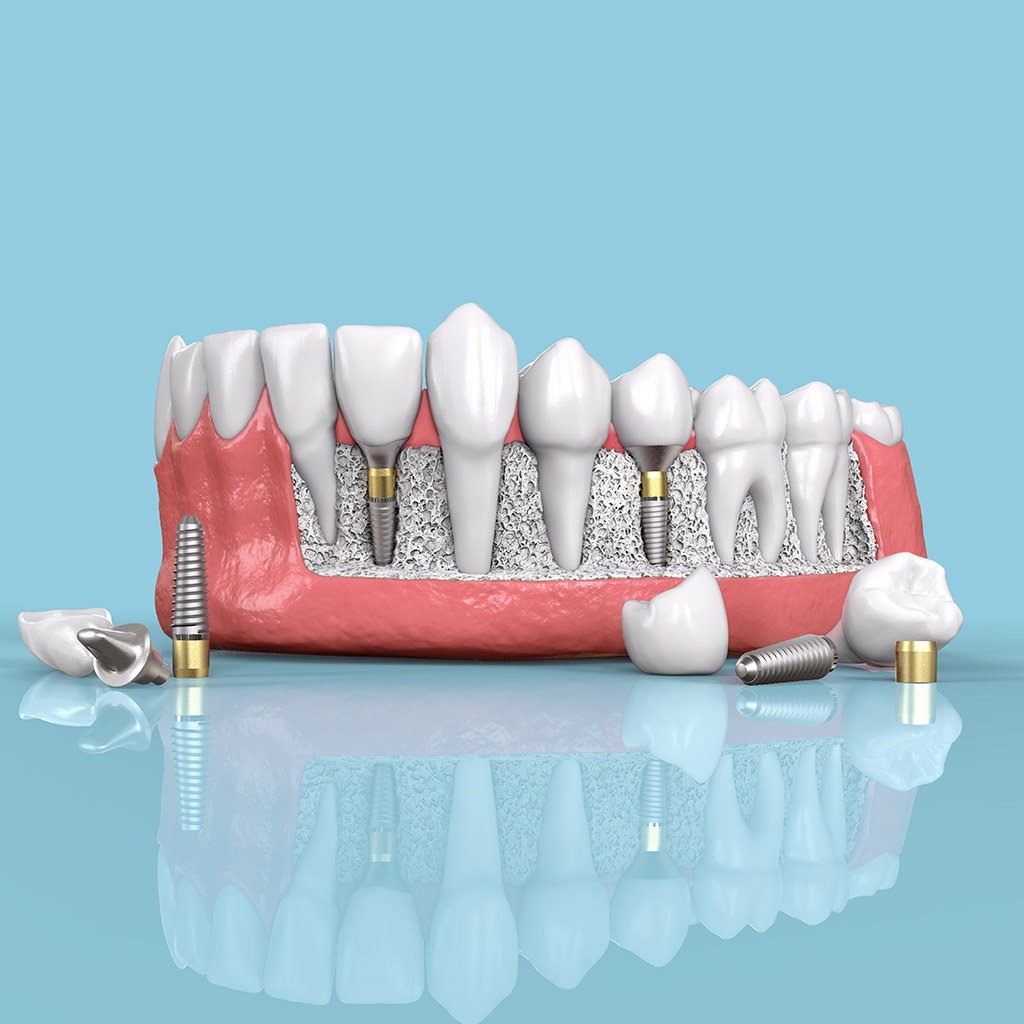
Dental Implant Treatment, A dental implant is the preferred method for replacing missing teeth nowadays, greatly surpassing bridgework and removable dentures. The actual implant that allows this is a titanium-made long piece of metal that looks similar to a screw. It will go directly into your jawbone where it will remain fixated firmly into place.
The implant effectively becomes the new artificial root that will hold the artificial, natural-looking tooth into place. This artificial tooth goes by the name ‘crown’ or ‘denture’ depending on the model you choose.
And it goes attached to the abutment, a separate part of the implant that goes on top of it and its added after the implantation properly heals. The artificial tooth chosen for you will match the colouration of the rest of your teeth and properly blend in with them.
The average lifespan of a single tooth placed during a dental implant treatment is 5 to 10 years with proper care. Thus, the procedure allows for the most natural-looking and long slating results when replacing a missing tooth. Restore your smile to its former, complete glory with an Implant treatment, the best option around to fix a lost tooth.
Missing a tooth is a serious thing. Not only it is discomforting, giving an awkward sensation int the mouth when you chew. It also becomes something of a major flaw in your appearance likely to affect your self-image negatively. Thus, having it replaced with a prosthetic would bring much relief to you physically as well as psychologically. The dental implant treatment is not the first nor only kind of tooth replacement procedure available. It is only the newest one which gives the best results seemed so far. Other treatments include:
- Full Denture and Partial Denture – Consist of a set of artificial teeth mounted on a framework made of plastic or metal. They are removable and can be custom made to fill an extensive gap of consecutive missing teeth.
- Bridges – Are artificial teeth that the surgeon joins to the natural teeth adjacent to the spot where your missing tooth stood at. Effectively ‘bridging’ the gap. The procedure can even cover badly decayed teeth not yet extracted by incorporating a hollow tooth to put over them.
Yet, none of those procedure offers the advantages afforded by the Dental Implant treatment. Besides providing a replacement tooth firmly fixated in place, it also reinforces the jawbone. The bone grating part of the treatment makes a bone-covered socket to place the implant. This socket holds fast the implant, abutment, and crown in place. But it also stimulates the jaw to keep growing and strengthening with each chew as it mimics the presence of an actual tooth. When teeth are missing, it disrupts the natural stimulus chewing causes to the jawbone to keep it strong. Denture or bridges can’t replicate that since they are not fixed on it. Thus, the treatment not only gives the best appearance but also helps keep the jaw healthy.
Before moving forward with the surgery, you need the doctor to tell if you, in fact, are a candidate at all. The surgeon request you undergo a series of imaging studies, such as x-rays and panoramic films, before the actual consultation. Remember to bring those studies with you to the initial consultation.
During the initial consultation, the doctor will take a look at the inside of your mouth. They will physically examine the part of the gum where the lost tooth formerly stood at. Additionally, they will take a look at the dental studies you already underwent before coming in. X-rays and panoramic films do provide a detailed look at the state your jawbone is currently in to know if the surgery can proceed.
If that is the case, based on their observations, the surgeon will know approximately how much bone graft the implant will require. During the consultation, the surgeon will also ask for your medical history as any other would when consulting for a surgical procedure. Also, remember to disclose any medications you are on and conditions you’ve been previously diagnosed with. If you currently smoke, the surgeon will tell you to stop for a number of weeks ahead of the first stage of the surgery.
The dental implant surgery necessarily happens in stages made up of different stages. The surgeon spaces them out to allow healing of the site after each stage of the procedure before moving further. There are three surgical stages for dental implant treatment.
The first part of it consists in the extraction of the remains of the tooth the patient seeks to replace. Even when this particular tooth broke off, a small part of bone remains within the gum whether visible or not. The surgeon either grabs a part of it protruding out of the gum and pull it out. Or opens up the gum with an incision and grabs it if there’s not enough of it showing on the surface. After extracting it, you will need a bone graft made of actual or synthetic bone. This because, as soon as you lose a tooth, the jaw bone begins to decay due to lack of physical stimulation. The graft will take the place of the tooth remains just extracted within the gum.
The graft itself will also serve to make a more accommodating room for the implant. Since the pressure exerted to the teeth when chewing is immense an Implant requires a strong foundation in order to sit still in place. Something that the jagged remains of a broken tooth will not provide. The graft made by your surgeon, however, will accommodate to the shape of the implant nicely. Once done with the grafting, the doctor closes the incision. Note that, before moving further with the surgery, you will require six months of recovery to let the graft take to the place.
Once your recovery period is over, you can swing by your surgeon’s office to get the actual implant of your implant treatment. With the bone-grafted cavity healed, the surgeon proceeds to drill the gum open to place the implant. The titanium-made implant post resembles a thick screw and will act as the root of your new artificial teeth. With the post in place, the surgeon sutures the gum around it to conclude the implantation. The titanium implant will integrate nicely with the bone but it needs other six months to fully do so. Thus, you will need another recovery period.
Some patients have exceptional bone mass on their jaws. This allows them to simultaneously have the extraction and implantation at the same time and without a resting period in between. Your dental surgeon will tell you if this is your case.
Besides having lost a tooth or many teeth, the dental implant treatment requires you are past the 18 years of age so your jawbone is fully grown. Besides that, dental surgeons have an ideal profile regarding which patients are most likely to have a successful implant treatment. This profile includes.
Have the time – As stated, the procedure can take more than a year to complete. Patients need to remain committed and plan ahead for the resting periods after each stage of the surgery for it to be successful.
Not Smoke – Smoking contributes to the buildup of bacteria in the mouth which leads to plaque which finally leads to gum disease. The condition weakens your gum and its ability to hold the implant in place. Also, smoking disrupts blood circulation and difficult healing from the surgery. If you smoke, cease the habit before each phase of the surgery and their respective recovery period.
Have Not Received Radiation Therapy on The Jaw – There are signs pointing that radiation therapy to treat cancer in that area affects the chances of the implant successfully taking. Disclose to your doctor if you already underwent it.
Q: Does it hurt to undergo dental implant treatment?
A: All parts of the procedure which require incision proceed under local anaesthesia. You will not feel any major discomfort.
Q: How long will my dental implant last?
A: Its lifespan covers 5 to 10 years top depending on the level of proper care given.
Q: Do I really need to rest for six months between each stage of the procedure?
A: Yes, you do. That is just how long it takes for the bone graft and the titanium implant post to take to the jawbone. Anything done sooner risks the success of the implant treatment.
